Another type of combat operations of the Belarusian partisans
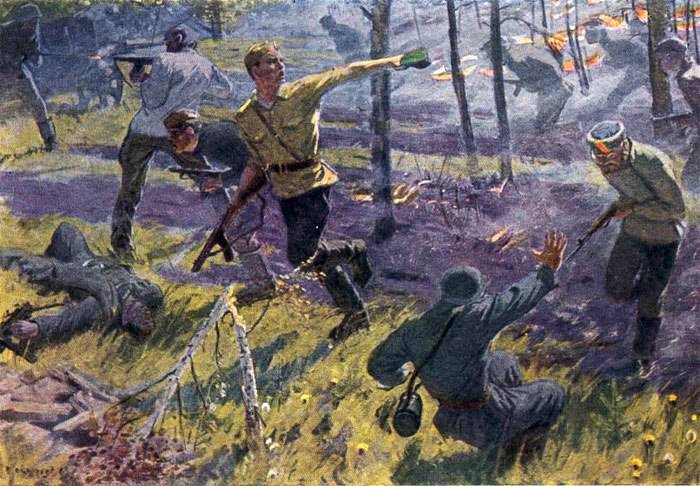
The entry of Soviet troops into the territory of Belarus in the autumn of 1943, their access to the base areas of large partisan groups, to partisan edges and zones, immediately affected the tactics of the partisans. The Belarusian headquarters of the partisan movement (BSHPD), planning the actions of the partisan units, began to more specifically take into account the tasks that had to be solved in the interests of the advancing troops. Partisan detachments and formations were supposed to ensure not only reconnaissance, the destruction of enemy communications, but also direct interaction with parts of the Red Army on the battlefield, including helping to seize profitable frontiers, strong points, resistance centers, ferries and bridgeheads, the liberation of populated points. All this partisans decided in the complex. The seizure of bridges and crossings on the water frontiers, keeping them until the approach of the attacking troops is part of a single process of struggle against the fascists. The success, the effectiveness of the interaction of partisan detachments with the advancing troops was largely due to the well-established centralized leadership of the partisan movement by the CSPA, BHPD, front-line and army headquarters, as well as the rich experience gained by the partisans in previous battles in the enemy rear.
Consider the actions of the partisans, breaking them into two phases: the first is the liberation of the eastern regions of Belarus first in the autumn of 1943 to May 1944 of the year, the second in Operation Bagration (June-August of 1944 of the year). During the preparation of operations in the autumn and winter of 1943 (Nevelskaya, Gomel-Rechitskaya, etc.), front and army headquarters, through operational representatives of BHPA, set specific tasks for guerrilla units operating in the areas of their attack, reconnaissance, conduct sabotage on German communications, capture and retention of crossings. The latter problem was solved in various ways. Detachments seized bridgeheads, bridges, ferries, fords on the rivers and held them until the approach of the Soviet troops. When this possibility did not appear, the partisans defended on one or both banks of the river, equipped a ferry there, concentrated boats and other improvised means, or kept bridgeheads on rivers, thus facilitating the crossing of water obstacles.
For example, in the course of the Nevelsk operation, the units of the Vitebsk partisans 2 in November 1943 of the year captured a number of German strongholds on the Drissa and Sinsha rivers and built the crossings. Partisan scouts were sent to the 4 shock army. They met in the Dudchino area the advanced units of the 219 Infantry Division and brought them to the crossings. The advancing units did not have to force these rivers to fight; they quickly crossed over the bridges built by the partisans. In the period of the Gomel-Rechitsa operation, the forces of the Central Front also closely cooperated with the Belarusian partisans. On the instructions of the command, the Gomel partisans struck a series of blows at the retreating enemy troops, captured and retained several crossings. Particularly distinguished in these battles was the Gomel partisan unit of commander I. P. Kozhara. The guerrillas of the compound continuously conducted sabotage in the rear, made daring raids on the headquarters, warehouses and communication centers of the enemy, in the area of Coast Sloboda blew up an enemy ferry. On November 19, they captured an 34 settlement on the west bank of the Dnieper and held them until parts of the 19-Rifle Corps arrived.
The partisans of Belarus took control of many ferries and bridges, blocked the railways and prevented the fascists from transferring reserves from Minsk and Brest to the Gomel area. The partisans of the Belarusian Polesie and the units of the Gomel and Minsk partisans took part in the ensuing battles. Thus, the Bolshevik Brigade (commander I. F. Gamarkko) of the Gomel BFAP guerrilla unit set the task with all its might to prevent the planned withdrawal of German troops. The guerrillas made blockages on the road, dug an anti-tank ditch, trenches, mined tank-hazardous areas from the village of Beregovaya Sloboda to the town of Gorval. For three days they held the approaches to the Berezina River, and the fascists could not break through on this section.
To deliver stronger and more effective attacks on the enemy, the headquarters of the Gomel Union decided to unite a number of brigades and detachments into one group. Her commander was appointed V.I. Sharudo, Commissioner E.G. Garden. The group was ordered to saddle the Gorvalsky way and not to give the fascists the opportunity to carry out the crossing to the left bank of the Berezina.
At dawn of November 18, three groups of groups secretly approached the outskirts of Gorval and, shouting “Hurray!” Unexpectedly rushed to the fascists. The enemy in a panic rushed to the river, but only some managed to reach the opposite shore. November 19 under the cover of artillery fire, the Germans unsuccessfully tried to dislodge the guerrillas from the village. In the evening, advanced units of the 37-th Guards approached Gorval. rifle division, Major General EG Ushakov - a battalion of machine gunners. Together, the warriors and partisans Gorval was completely liberated from the Germans. The crossing of the fascist troops across the Berezina was disrupted.
Guerrilla groups I.G. Borunova and G.I. Sinyakova successfully interacted with units of the 55 th infantry division of the 61 th army. So, on November 22, when the 111 th Infantry Regiment reached the Braginka River, the partisans, at nightfall, hit the fascists from the rear and helped the Red Army units quickly force the river and capture the regional center of Bragin.
During the preparation and conduct of the Mozyr-Kalinkovichi operation, the Polissya partisans, by order of the BSPA, established close cooperation with parts of the 61 Army. At the end of 1943, the commanders of the Mozyr, Narovlya and Yelsk partisan brigades came into contact with the commanders of 2 (Lieutenant-General VV Kryukov), 7 (Major General MP Konstantinov) of the Guard cavalry corps. The guerrillas helped the cavalry units to cross the Pripyat River at night, and led them to the rear of the enemy with forests. Concentration was held secretly from the enemy. The German command did not expect that the Soviet troops could quietly overcome the river and impassable swamps and go to their rear.
The blow from the front and rear was overwhelming for the enemy. As a result of a skillful bypass maneuver of a part of the 61 army, interacting with the neighboring 65 army and with the support of guerrilla forces, on the night of January 14, 1944 broke into Mozyr and captured it. In addition, a group of partisans commanded by A.D. Kolosa was undermined by the railway bridge on the Ippa River, which blocked the Nazis to the west.
BSHP paid great attention to the intelligence of the German defense on the water frontiers. So, long before the beginning of the offensive operation of our troops, 21 February 1944 of the year, the operational group BHPD on the Western Front set specific tasks to the guerrilla forces. Guerrilla regiment I.F. Sedchikova received the task of conducting reconnaissance of the state of the enemy defensive line in a number of sections along the Zapadnaya Dvina River, the brigade S.N. Narchuka - on the Dnieper River, brigade G.A. Brick - on the river Berezina, team Z.P. Gaponov - along the Dnieper and Drut rivers, the regiment S.V. Grishina - along the Dnieper, Berezina, Lokhva, Drut, and Olsa rivers. Similar tasks were given to the Baltic and Belarusian fronts.
In carrying out the tasks of the BHPD, the partisans launched a broad intelligence activity and presented to the front command very valuable information about the state of the defensive lines built by the Nazis on the water lines, on the presence and nature of crossings over the rivers in enemy rear. Thus, the 1 of March 1944 of the military operative group at the Shklovsky underground RK KP (b) reported to the headquarters of the Western Front information about the enemy fortifications on the Dnieper River and the presence of ferries here. Detailed intelligence information about the enemy came from the partisans to the front headquarters before the start of the Soviet offensive operation. Thus, during April-May 2 of the 1944 Belorussian Front headquarters regularly received reconnaissance information from partisans about the state of enemy defenses on the western banks of the Mereya, Pronya, Basya, Resta, Dnepr and Drut rivers in the Mogilev direction. All information received from the partisans was carefully studied, compared with other intelligence data and used in planning and during the operation.
Based on the orders of the Central Committee of the CPSU (b), the Supreme Command Headquarters, the Central Committee of the Communist Party (Bolsheviks), BSHPD (Chief of Staff PZ Kalinin), by the summer of 1944 of the year developed specific plans for guerrilla warfare for the period of “Bagration”, which were coordinated with the command fronts. Partisan units of the Vitebsk, Vileika, northern Minsk and Baranavichy regions, in particular, had to strike at the most important fascist communications, hold the bridgehead occupied by the Berezina River until the Red Army units arrived, ensuring the offensive of the 1 Baltic and 3 Belorussian connections fronts. The partisan formations of the Mogilev region, brigades deployed in the east of the Minsk region, were supposed to provide support to the troops of the 2 of the Belarusian Front forcing the Dnieper. Polesye, Yuzhno-Minsk, Pinsk and Belostok partisans were tasked with creating the right conditions for deploying the offensive of the 1 of the Belorussian Front.
All the tasks assigned to the partisan formations were successfully completed. Thus, on the fourth day of the offensive operation, in the 28 Army action zone, four brigades of the Minsk partisan unit (commander V.I. Kozlov), carrying out the task of the BSPD, seized a bridge in the area of Berezovka, Glusk district, and concentrated 40 boats and helped parts of the 48 gd. Rifle Division force the river Ptich.
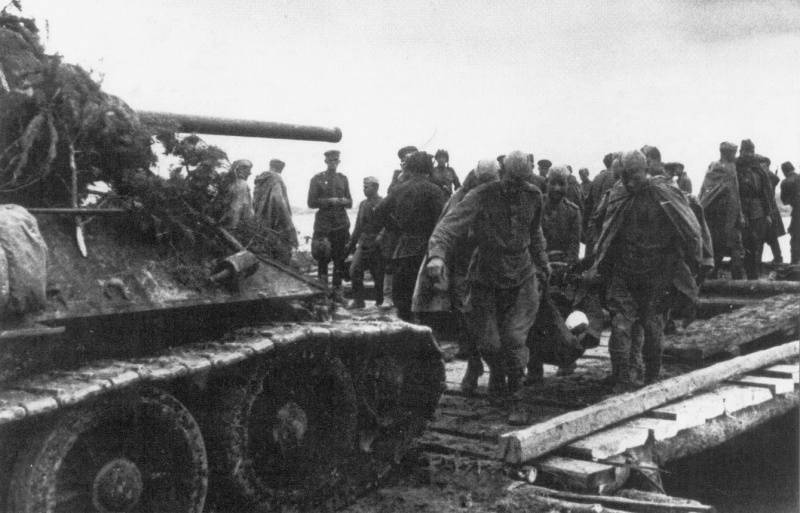
During the 26-28 of June, fierce battles to retain the crossings of the Ptich River in the area of Rozhanov, Kholopenichi fought partisan brigades of the Belarusian Polesye, which were commanded by I.M. Kulikovsky, V. Z. Putyato, I.M. Kulikovsky N.D. Kuranov, I.N. Merzlyakov, M.A. Volkov et al. Fighting five guerrilla brigades to capture ferries on the river Sluch in the Starobin-Slutsk area, coordinated by the BHPA representative 37 Guards representative. Rifle Division 65 Army Major B.M. Chertok.
37-I partisan brigade them. Parkhomenko (commander A.V. Lvov) and the 64 Brigade named after Chkalov (commander N.N. Rozov) captured the crossing of the Sluch river at the Starobin-Pogost section and held it for several days until the approach of the Soviet troops. Taking advantage of the crossings captured by the partisans, the troops of the 28 Army continued to pursue the enemy on a broad front and, together with the partisans, smashed his disparate groups. The crossings on the Ptich River between Kholopenichi and Porech captured the 161-I partisan brigade (commander A.S. Shashur), they were used by units of the 20-Infantry Corps.
In the action zone of the 2 of the Byelorussian Front, Mogilev guerrillas captured bridges and crossings. So, the 61-th partisan detachment (commander G. K. Pavlov), for seven hours 27 June led a hard battle for crossing the river Drut, near the village of Gorodishche, Mogilev region. The guerrillas kept the crossing and transferred it to the approached units of the 238 Infantry Division. The success of the hostilities aimed at seizing water lines was facilitated by carefully conducted preliminary reconnaissance of river fords and crossings.
The partisans of the Begoml brigade Zheleznyak (commander I.F. Titkov) captured and held the crossing across the Berezina. With the approach of the 35th Guards. tank brigades, they built two bridges over which tankers were able to cross to the opposite bank. After that, the partisans in the role of a tank landing freed Dokshitsy, Dolginovo and the Parafyanovo railway junction.
In addition to capturing bridges and crossings and transferring them to the advanced units of the Red Army, partisans and local residents made a lot of efforts to restore the bridges and crossings destroyed by the Germans, and to build new ones. Thus, the Chekist brigade (commanded by G. A. Kirpich) built 5 bridges on the river Mozha near the village of Ukhvali for the 2 Guards. tank corps. Smolensk partisan regiment I.F. Sadchikova, after connecting 2 in July with parts of the 1 of the Baltic Front on the River Viliya, helped the 1 tank corps to restore four crossings and two destroyed bridges. The guerrillas also reported important information about the enemy defense along the river Viliya. Similarly, the guerrillas of the N.N.G. 16 Smolensk Brigade distinguished themselves. Shlapakova. Under the enemy bombs 2, 4 and 6, the brigade detachments aggressively led to the restoration of the bridge near the village of Mihalishki. The partisans performed the task perfectly. Having freed 4 on July the town of Svir, they kept the bridge over the river until the approach of parts of the Soviet troops.
Actively participated in the liberation of Belarus and the partisans of the western regions of the republic. Thus, the partisans of the Baranovichi formation (commander VE Chernyshov), on the instructions of the Soviet command, foiled attempts by the invaders to consolidate on the Neman River. The 1 Belorussian Cavalry Partisan Brigade (Commander DA Denisenko) occupied the 2 July defense on the left bank of the Neman at the Eremici-Bykovichi line. The cavalry guerrillas for almost the whole day reflected the attempts of the fascists retreating from Minsk to cross the Neman and enter the Turets-Korelichi road.
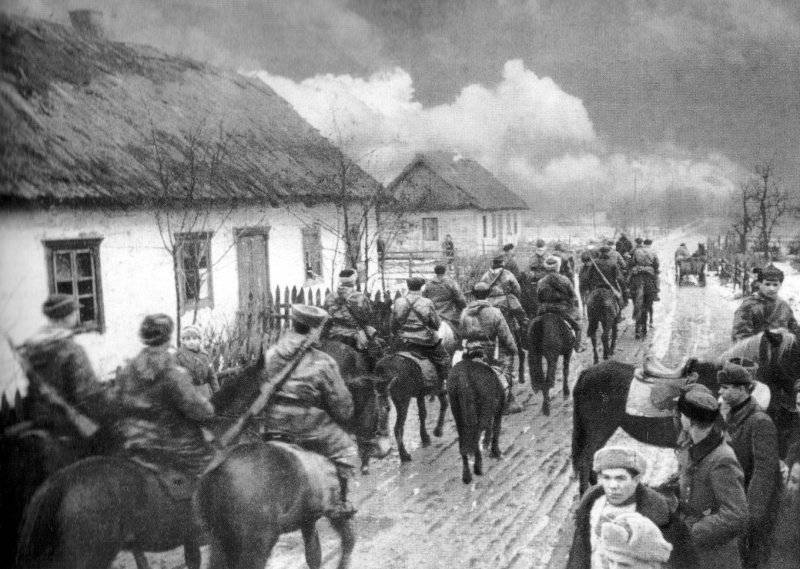
Fulfilling an order from the commander of the 1 Mechanized Corps, Lieutenant General S.M. Krivoshein, Baranovichi partisans seized the bridge over the river Shchara on the highway Slutsk Brest and kept it until the approach of the corps parts. The bridge was saved, and our tanks without delay rapidly went forward, to the west. In the battles in the direction of Baranovichi, a partisan brigade named after I.V. Stalin V.A. Tikhomirov. On July 3, in the Zavshitsa-Starchitsa-Krivichi area, the team merged with the 3-th Guards. tank hull. The guerrillas helped the tank crews to arrange crossings over the Moroch River, provided tank columns with guides and scouts to Baranavichy. Well-oriented in the terrain, they led Soviet troops to deep enemy rear, conducted reconnaissance of bridges, fords and crossings on rivers, organized the population for the construction and restoration of bridges, crossings, and repair of access roads. The partisans of the Vileyka region, for example, built more than three hundred bridges and fifteen crossings over the water lines.
After connecting with the Red Army units, partisans and underground fighters, with the help of the local population, led to the restoration of destroyed roads and crossings, ensuring the non-stop advancement of the advancing Red Army units. Only the partisans of the 2 of the Minsk Brigade N.G. Andreeva, with the active assistance of local residents, built 39 bridges for three days, dismantled a lot of debris and filled up 75 ditches on the roads. This was the way the partisans of the whole republic acted, assisting the fastest advance of the Red Army to the west.
In the period of the battles for the liberation of Belarus, the partisans closely cooperated with our attacking troops in the operational and tactical level. The capture of important frontiers by partisans, bridges and crossings in the enemy's rear contributed to increasing the rate of advance of the troops, forcing them from the course of water obstacles, disrupted the plans of the German command to systematically withdraw troops to the rear defensive lines. With the help of partisans and local residents, the Soviet troops overcame such rivers as the Berezina, the Drut, Sluch, Ptich, Vilia, Neman, Shchara and many others almost without any delay. The command of the fronts highly appreciated the actions of the partisans in capturing crossings and bridges during the period of the “Bagration” operation, pointing out that the partisans were able to significantly paralyze the fascists' retreat routes, making it difficult to regroup and ensure the supply of troops. By this the partisans made a significant contribution to the defeat of the German troops in Belarus.
Sources:
Zalessky A., Letunov A., Andryushchenko N. and others. In the terrible years. Minsk: Belarus, 1973. C. 346-348.
Arbuzov A., Balandin K., Belyaev A. and others. Guerrilla and underground struggle in the occupied territory of Belarus // the Great Patriotic War of the Soviet people. Minsk: BNTU, 2011. C. 76-89.
Antonov S., Bolkhovitin A. et al. Guerrilla Crinic. Minsk: Belarus, 1972. C. 241-244.
Dolgotovich B. Assistance of partisans of Belarus to parts of the Soviet Army // VIZH. 1976 No.8. C. 89-94.
A group of authors. Nationwide partisan movement in Belarus during the Great Patriotic War. T. 1. Minsk: Belarus, 1967. C. 186-209, 272-291, 649-651.
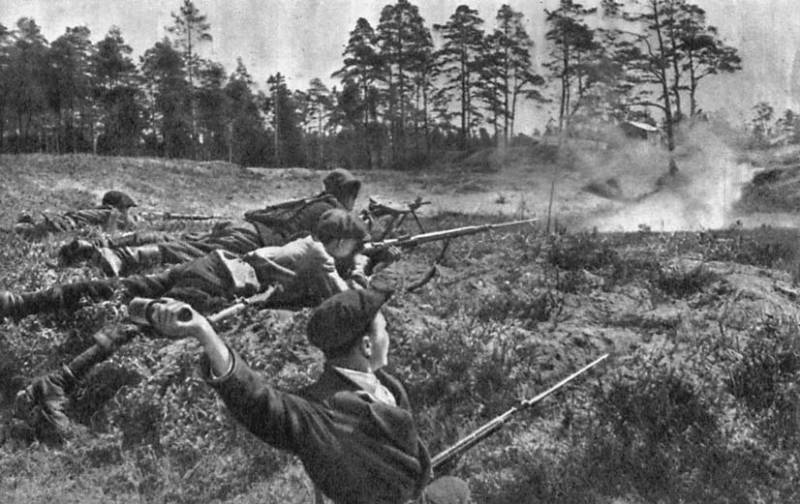
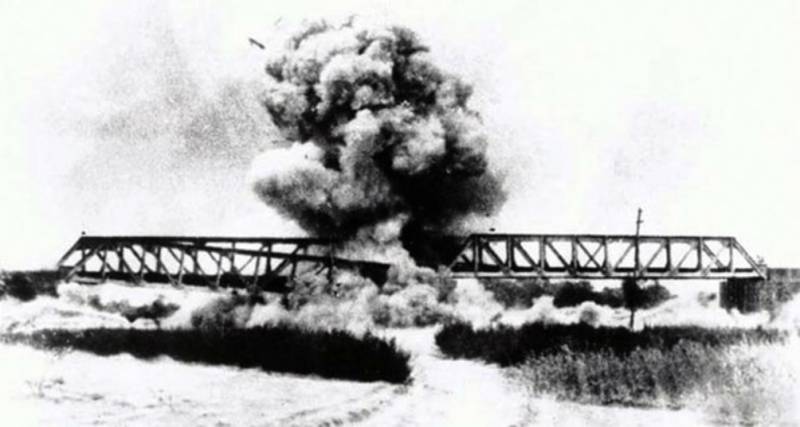
Information